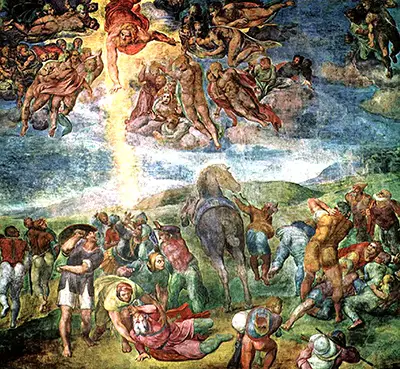A Fresco housed in the Vatican City, The Conversion of Saul was painted between 1542-1545 and is more Mannerist in its style than many of Michelangelo's previous works.
It marks a development both in his personal style and in his use of colour.
It shows the biblical story of the conversion of the brutal and cruel Saul of Tarsus into Paul the Apostle. In the biblical tale Saul is an assiduous hounder and relentless persecutor of Christians, and is on the road to Damascus in order to arrest more when struck by a blinding shaft of light and confronted from the heavens by God, who asks him why he's persecuting him.
Suitably impressed by this intervention, The Hebrew Saul becomes the Latinate Paul. A famous tale, the phrase "Damascene Conversion" is used to this day to describe anyone who's had a fundamental change in outlook.
The fresco shows Michelangelo at the height of his powers, and experimenting with pushing his style. The action describes a graceful line running from the top left, where the face of a God-figure appears surrounded by a host of angels, down through the middle of the painting to the downed Saul, thrown from his horse, which is understandably startled at this turn of events.
In Medieval art, the unhorsing of someone was often a signifier of a loss of pride and so it is in this case, the prideful Saul being brought low before God.
The scene is packed with activity, the fresco is one of Michelangelo's busier works, the crowds of figures recalling the tightly packed groups of "The Deluge". There are two main groupings; the crowds of earthbound humans surrounding the downed Saul mirror the throng of angels surrounding God.
The figures are slightly exaggerated, this painting anticipates the later, more Mannerist paintings of El Greco and Pontormo; for a painter known for his anatomical precision, this Mannerism is telling: Michelangelo is depicting a story so remarkable, he seems to imply, that standard depictions of the human form won't do the strangeness of the situation justice.
The use of colour is extraordinary, there is a clear delineation between the blues of heaven and the greens of the earth. Michelangelo is using colour to highlight the difference between the earthly and divine, yet the two are linked by the intense yellow of the pulse of light raining down upon Saul.
The intensity and vividness of these hues are something of a departure for the time, and add further weight to the idea that Michelangelo was using this fresco to push at the boundaries of his style and abilities. The work, for this reason, will actually remind many of the work of Peter Paul Rubens.
With The Conversion of Saul, Michelangelo was cementing his reputation as an innovator at the same time as underlining his abilities as a master of painting; the precision of the brushwork gives him license to take liberties with form and colour. This is the work of a master at the height of his powers.
Conversion of Saul is a fresco sometimes referred to as Conversion of St Paul.
This stunning fresco can now be found at the Cappella Paolina, Vatican Palace in Vatican City.
This painting took Michelangelo in a new direction with a more mannerist approach, underlining his constant desire to try out new techniques. This bold approach unfortunately did not get sufficient support from academics at that time, though, and left this painting being considered below the standard of much of what he had produced earlier in his career.
Art experts of more recent centuries have shown a far greater respect for this painting and the later work of Michelangelo in general, with Mannerist art being seen far differently now than to when it first appeared across the art world.


